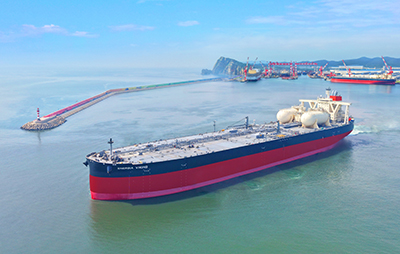309,000-ton VLCC ENERGIA VIKING Delivered - The first LNG-fueled VLCC from Kawasaki Group -
Sep. 29, 2025

Tokyo, September 29, 2025 — Kawasaki Heavy Industries, Ltd. delivered today the ENERGIA VIKING (Kawasaki hull no. 8091, DACKS hull no. DE146), a very large crude oil carrier (VLCC), to MOL ENERGIA PTE. LTD. The vessel was delivered at the Dalian COSCO KHI Ship Engineering Co., Ltd. (DACKS) shipyard, which is located in Dalian, China and operated jointly with China COSCO Shipping Corporation Limited. The ENERGIA VIKING is the first LNG-fueled VLCC as a vessel from Kawasaki Group.
Features
- Kawasaki's new VLCC replaces the conventional bulbous bow with a newly designed bow form that extends the vessel's length at the waterline. This new design greatly reduces wave-making resistance from bow waves during navigation, enabling greater propulsive performance.
- The use of a low-speed, ultra-long-stroke main engine together with a high-efficiency, large-diameter propeller provides low fuel consumption.
- As the first VLCC from our Group, this vessel is equipped with the dual-fuel main engine which is compatible with both LNG and LSFO (lower sulfur fuel oil). When using LNG fuel, the emissions are expected to be reduced as follows: For carbon oxide (CO2) by approx. 25 - 30%, for sulfur oxide (SOx) by 100%, for nitrogen oxide (NOx) by approx. 85%, compared with the conventional heavy-oil-fueled main engines. The vessel complies with the EEDI Phase3*1, which regulates the CO2 emissions from VLCCs to be contracted in and after FY2025.
- With the installation of SOx scrubbers*2 at the exhaust gas outlets of the main engine and power-generation system, the vessel meets the reinforced requirements of SOx emission regulations*3, which came into force in January 2020. By installing this equipment, the cost for fuel oil is expected to be reduced since the conventional fuel oil will still be compatible after the regulation reinforcement.
| Principal Particulars | |
|---|---|
| Length overall x breadth x depth | 339.50 m x 60.00 m x 28.90 m |
| Molded draft | 21.03 m |
| Sea speed | Approx. 15.45 knots |
| Complement | 37 people |
| Gross tonnage | 166,708 tons |
| Deadweight | 309,999 tons |
| Cargo hold capacity | 352,151 m3 |
| Main engine | One MAN B&W 7G80ME-C10.5-GI-HPSCR diesel engine |
| Classification / Country of registration | ClassNK / Panama |
| Date of delivery | September 29, 2025 |
| *1 | EEDI (Energy Efficiency Design Index) regulation: The international regulation to enforce the compliance with the regulatory values related to the energy-saving performance of newly-built vessels by the Energy Efficiency Design Index (EEDI), which is defined as the number of grams of CO2 to be emitted when transporting a cargo weighing a ton for a distance of a mile. The EEDI regulatory values will be reinforced in a phased manner according to the dates of construction contract and delivery. In Phase 3, the vessels to be contracted in and after FY2025 will be requested to reduce the CO2 emission by 30%, compared with Phase 0. |
| *2 | SOx scrubber: Equipment to eliminate the sulfur oxides (SOx) in exhaust gases |
| *3 | SOx emission regulation: Since January 2015, within the emission control areas (ECAs) in Europe and the United States, the SOx emissions regulation has been implemented so that fuel with 0.1% or less sulfur content is applied. In addition, since January 2020, for the vessels sailing all other coastal areas in the world, it has been mandatory to apply either fuel with 0.5% or less sulfur content or alternative equipment to reduce the SOx emissions from exhaust gases to the same degree. |
Related links
Kawasaki Receives Order for Two 309,000 DWT Class, LNG-fueled VLCCs (August 25, 2022)
https://global.kawasaki.com/en/corp/newsroom/news/detail/?f=20220825_7782
Contact
If you need more information about our business,
please feel free to contact us.





